Purple-flowering plants can turn any ordinary space into a royal sanctuary, offering a unique visual break from the typical green foliage. In this article, we delve into 11 houseplants that produce flowers in different shades of purple, each with its own unique requirements and aesthetic charm.
Also, if you’re looking to extend the purple theme even further, be sure to check out our article on houseplants with purple leaves.
Table of Contents
1. African Violet (Saintpaulia)

Coming from the regions of Tanzania and southeastern Kenya, African Violets are loved for their velvety foliage and colorful flowers. These low-growing plants are regulars in our articles, thanks to their diverse assortment of varieties. For in-depth care advice, check out our dedicated article on growing and caring for African Violets.
- Ease of Care: Easy; needs moderate to bright indirect light and well-draining soil.
- Flowering Season: Year-round, if given the right conditions.
- Best for: Windowsills, desks, and small spaces.
- Recommended Cultivars: ‘Optimara EverPrecious’, ‘Summer Twilight’
2. Cape Primrose (Streptocarpus)

Also known as Streptocarpus, Cape Primrose comes with long, slender leaves and bright purple trumpet-shaped flowers. Native to South Africa, they are a relative of the African Violet and equally charming.
- Ease of Care: Moderate; prefers bright, indirect light and moist, well-draining soil.
- Flowering Season: Late winter to early summer.
- Best for: Hanging baskets or tabletop displays.
- Recommended Cultivars: ‘Harlequin Blue’, ‘Polka-Dot Purple’
3. Gloxinia (Sinningia speciosa)
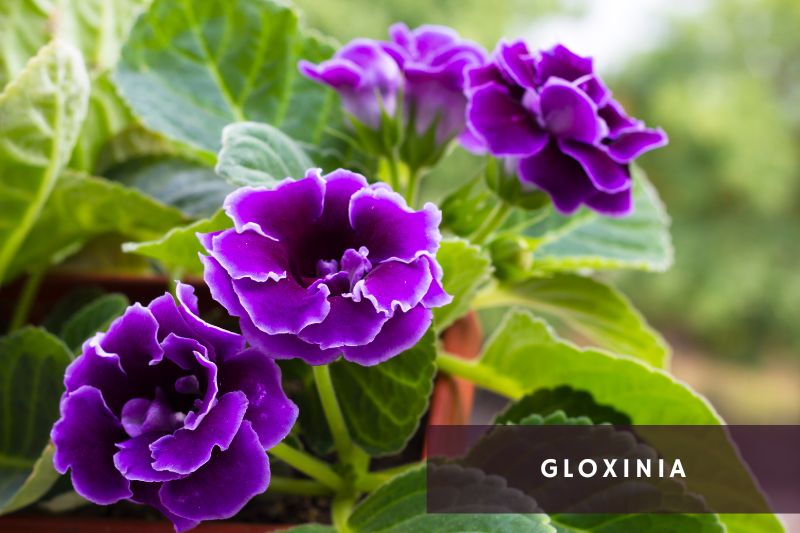
Gloxinias have velvety, bell-shaped flowers in a rich shades, including purple. Native to Brazil, they often feature patterned leaves, adding extra visual interest.
- Ease of Care: Moderate; prefers high humidity and indirect light.
- Flowering Season: Late spring to summer.
- Best for: Tabletops and shaded terrariums.
- Recommended Cultivars: ‘Violacea’
4. Cyclamen (Cyclamen Spp.)
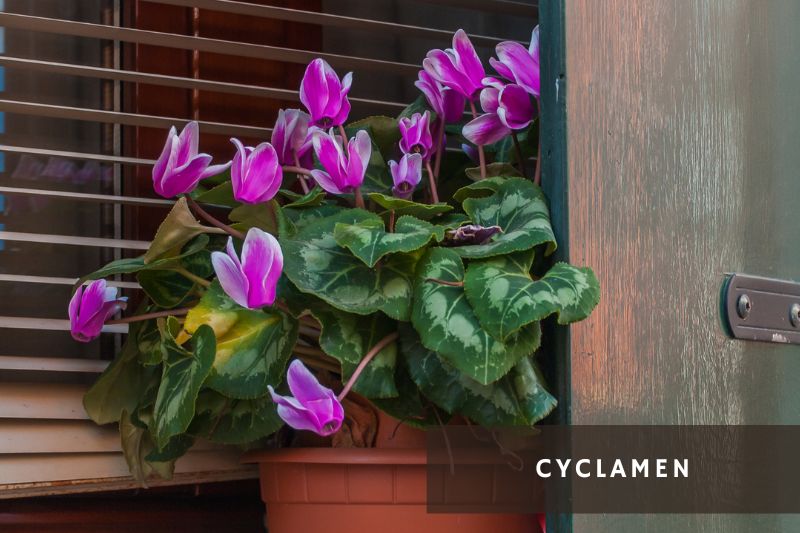
Cyclamen are known for their unique flower shape and contrasting leaf patterns. Native to the Mediterranean region, they offer a burst of color during the colder months.
- Ease of Care: Moderate; needs cool temperatures and indirect light.
- Flowering Season: Fall to early spring.
- Best for: Windowsills and cool rooms.
- Recommended Varieties: Cyclamen purpurascens, Cyclamen repandum
5. Air Plants (Tillandsia)
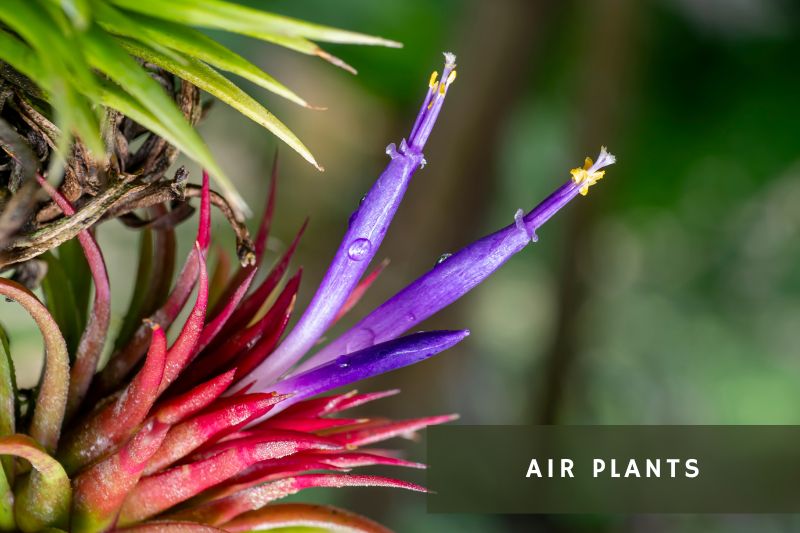
Air plants, also known as Tillandsia, are unique in their ability to grow without soil. These epiphytic wonders often surprise with their stunning blooms, which marks the start of the reproductive process in their lifecycle.
If you want to learn more about what happens with Tillandsias post-flowering, be sure to read our article titled “Do Air Plants Die After Flowering?“
- Ease of Care: Easy; needs bright, indirect light and occasional misting.
- Flowering Season: Varies by species.
- Best for: Terrariums and hanging displays.
- Recommended Cultivars: Tillandsia ionantha ‘Rubra’, Tillandsia aeranthos
6. Fuchsia (Fuchsia spp.)

Fuchsia plants are known for their drooping, tubular flowers that come in a variety of shades, including purple. They are a magnet for hummingbirds when grown outdoors.
- Ease of Care: Moderate; requires bright, indirect light and regular watering.
- Flowering Season: Late spring to early fall.
- Best for: Hanging baskets and container gardens.
- Recommended Cultivars: ‘Delta’s Sarah’, ‘Winston Churchill’
7. Bat Flower (Tacca chantrieri)
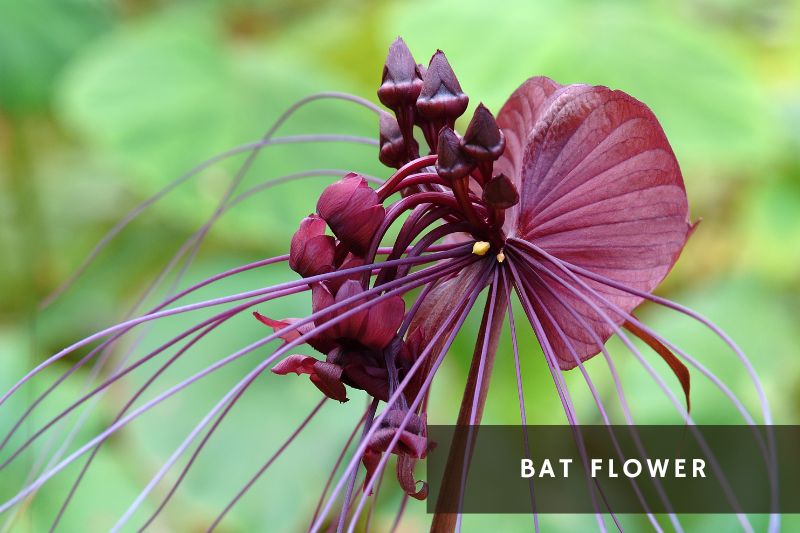
The Bat Flower is an unusual plant with dark purple-black flowers that resemble bat wings. Native to Southeast Asia, it’s a real showstopper but can be challenging to grow.
- Ease of Care: Difficult; needs high humidity and warm temperatures.
- Flowering Season: Late summer to early fall.
- Best for: Experienced gardeners looking for a challenge.
- Recommended Cultivars: Tacca chantrieri ‘Nivea’, Tacca integrifolia
8. Vanda Orchid (Vanda spp.)

Vanda Orchids are known for their vibrant, large flowers and aerial root system. They are native to Asia and are highly prized by orchid enthusiasts.
- Ease of Care: Moderate to Difficult; requires bright light and high humidity.
- Flowering Season: Spring and summer.
- Best for: Orchid enthusiasts and greenhouses.
- Recommended Cultivars: Vanda ‘Pachara Delight’, Vanda coerulea
9. Purple Heart (Tradescantia pallida)
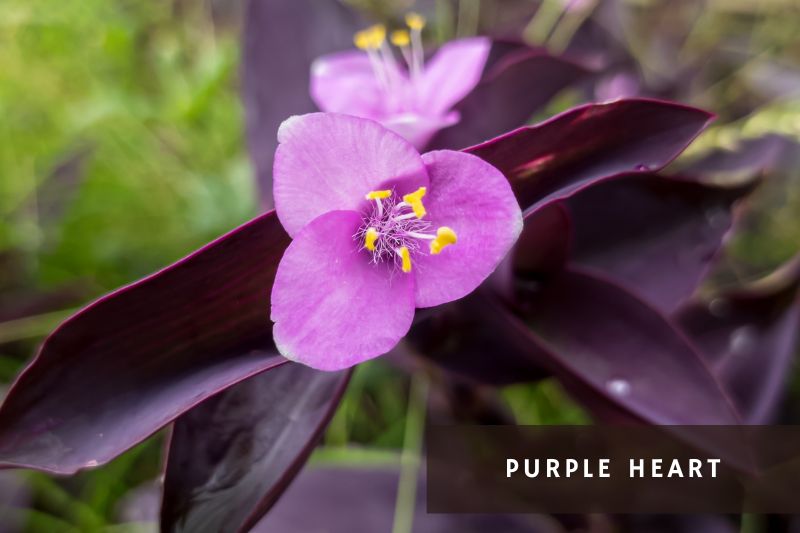
Purple Heart is mostly known for its purple foliage, but it also produces small, three-petaled purple flowers. Native to the Gulf Coast region of eastern Mexico, they are highly adaptable and drought-resistant.
- Ease of Care: Easy; tolerates a range of light conditions and is drought-resistant.
- Flowering Season: Late spring to early fall.
- Best for: Ground cover and hanging baskets.
- Recommended Cultivars: ‘Purple Queen’, ‘Greenlee’
10. Mona Lavender (Plectranthus ‘Mona Lavender’)

Mona Lavender is a hybrid Plectranthus, known for its dark green leaves and spikes of lavender-purple flowers. It’s a fast-growing, bushy plant perfect for indoor settings.
- Ease of Care: Easy; prefers bright, indirect light but tolerates low light.
- Flowering Season: Late summer to early winter.
- Best for: Windowsills and tabletops.
11. Petunia (Petunia × atkinsiana)

Petunias are usually grown as annuals and are popular for their wide range of colors, including vibrant purples. Though generally grown outdoors, they can adapt to indoor conditions if given enough light.
- Ease of Care: Easy; needs bright light and well-draining soil.
- Flowering Season: Late spring to early fall.
- Best for: Hanging baskets and container gardens.
- Recommended Cultivars: ‘Night Sky’, ‘Purple Wave’
Conclusion
We hope this article on indoor plants with purple flowers has inspired you to diversify the hues of your indoor garden. From the low-maintenance African Violet to the more challenging Bat Flower, there’s a purple-flowering plant to suit every gardener’s skills and tastes.
And if you’re interested in adding even more color to your indoor garden, be sure to read our other specialized guides. Discover the brightness of yellow-flowering houseplants, the allure of red blooms for indoor gardens, the elegance of white flowers in your home, and the vibrant cheerfulness of houseplants with orange blossoms.
No matter your color preferences or gardening experience level, there’s a flowering houseplant that’s perfect for you.

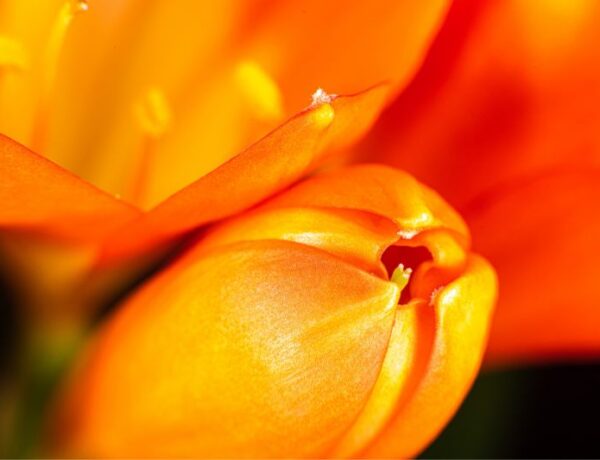

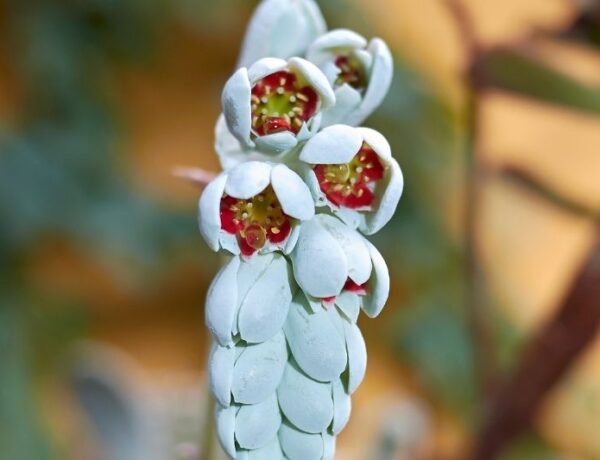


No Comments